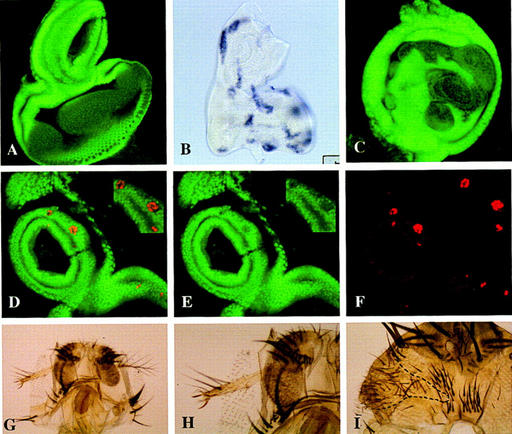Figure 6.
Ectopic expression of Hoxd10 or Ubx prevents the nuclear translocation of Exd in the antennal cells. (A) Confocal image with the expression of Exd in a wild-type eye–antennal disc. Exd is nuclear in the proximal and cytoplasmic in the more distal regions. (B) Eye–antennal disc dissected from a larvae of FLP; Arm>y>Gal4/UAS–Hoxd10 genotype heat shocked at 37°C and stained for Hoxd10 mRNA. Clones of Hoxd10-expressing cells can be detected all over the disc. (C) Confocal image of an eye–antennal disc from a larva of the same genotype and treated as in B, stained with anti-exd antibody. The patches of cytoplasmic Exd are likely to be clones of Hoxd10-expressing cells in which the nuclear translocation of Exd is prevented. (D–F) Clones of Ubx-expressing cells (red) affecting Exd (green) localization. (D) Confocal image of an eye–antennal disc with several clones containing ectopic Ubx activity stained for Exd and Ubx. No overlapping of the nuclear expression of both proteins is observed. (E) Confocal image of the same disc as D, stained for Exd and showing cytoplasmic expression. (F) The same portion of the disc as in E showing the clones containing Ubx expression. (G) Adult head with a clone of Hoxd10-expressing cells marked with y and showing a leg transformation. (E) Higher magnification of the clone shown in G. Note the presence of two claws. (F) Clone of Hoxd10+ cells (encircled) in the head capsule exhibiting a transformation toward thorax.

